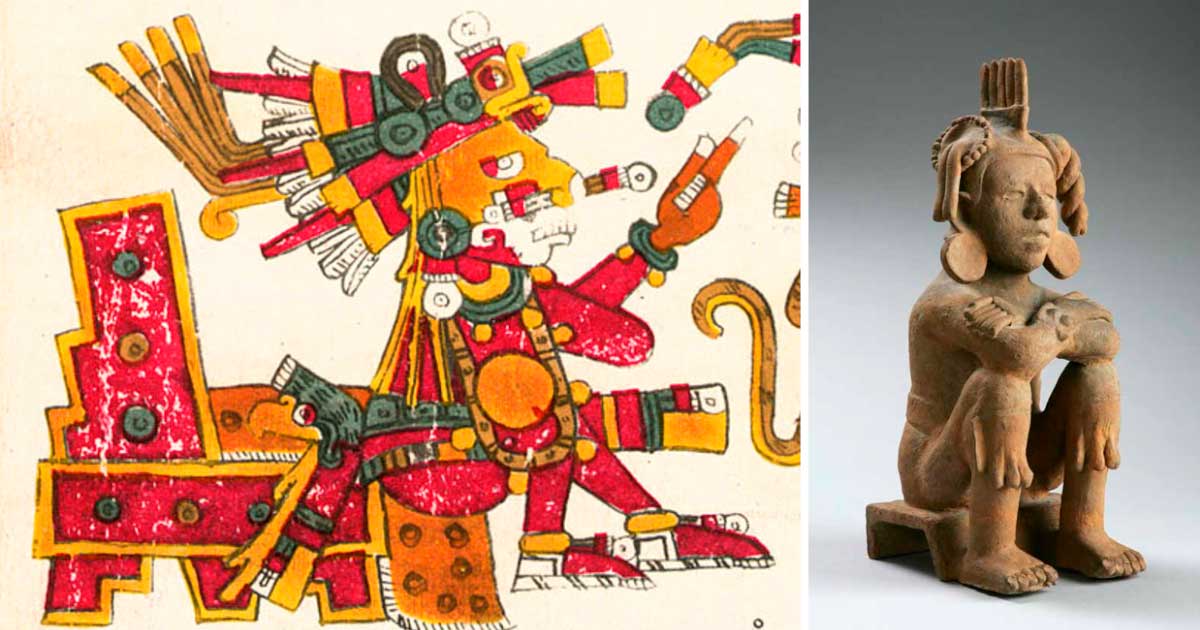Xōchipilli: Fun-Loving Aztec God of Sex, Drugs, and Music
The Aztecs were known for their many unique deities, but one of the most fascinating is Xōchipilli, the Aztec god of flowers, love, art, and fertility, as well as patron of homosexuality. Xōchipilli’s name literally translates into “flower prince,” a title clearly depicted by his famous statue. Xōchipilli was heavily worshipped during various religious ceremonies and festivals during the 14th and 15th centuries and has strong ties to the hallucinogens used during these events.
So what do we know about Xōchipilli, and how do we know it? What discoveries have been made that have led us to these conclusions?
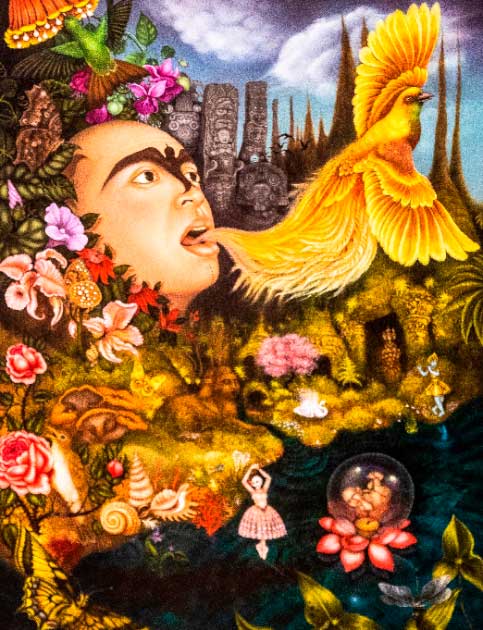
Xochipilli's Ecstatic Universe, oil painting by Mexican artist Tino Rodriguez, 2004 (Thomas Hawk / CC BY NC 2.0)
Xōchipilli’s Statue: Discovery of a Flower-Covered Figurine
During the 19th century, a great discovery was made near Tlalmanalco. Along the side of the Popocatépetl volcano, an ancient Aztec statue of Xōchipilli was discovered in excellent condition. The statue was made of stone and measured approximately 1.2 meters (3.9 feet) in height. Researchers assessed the statue and determined that it was created sometime in the 16th century.
The statue depicts Xōchipilli sitting cross-legged on a sacred base. Both Xōchipilli and his base are covered in various organisms, including hallucinogenic mushrooms, tobacco, morning glories, cacahuaxochitl, and sinichuichi. There is an additional flower on the statue that experts have not yet identified. It is possible that this flower is now extinct, although experts are still working to identify it. The statue also has a few butterflies on it, an insect Xōchipilli loved due to its grace and beauty.
Xōchipilli himself sits atop his intricate throne with his head tilted up toward the sun. His eyes and mouth are open, as are his arms to open his body to the heavens. It is likely that this position is in reference to the Aztec’s worship of the sun. This position symbolizes Xōchipilli’s carefree, relaxed attitude about life and his love for living things. Overall, the statue does an excellent job depicting Xōchipilli and the many domains for which he was responsible.
Some experts believe the statue depicts Xōchipilli in a hallucinogenic state due to dilated pupils and the presence of psychedelic mushrooms. While this is likely due to the abundance of hallucinogenic mushrooms used in Aztec ceremonies, it cannot be said for certain if this was the artist’s intention.
- Xolotl – The Underworld Dog God of the Aztecs
- Religion of the Aztecs: Keeping the Balance in an Unpredictable and Terrifying World
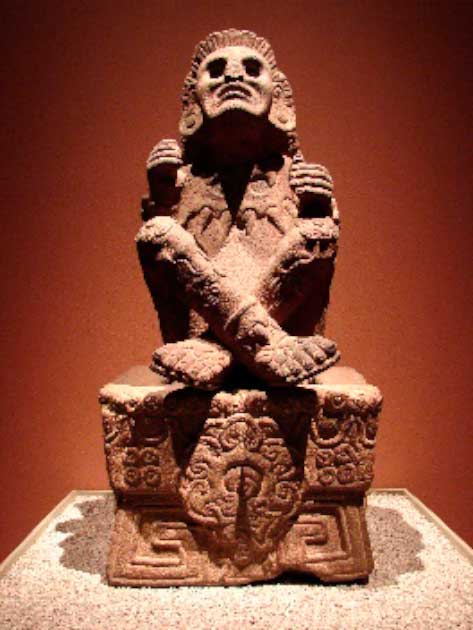
Statue of Xōchipilli from the Late Postclassic Period (1250-1521), discovered near Tlalmanalco, now on display at the National Museum of Anthropology, Mexico City (Antony Stanley / CC BY SA 2.0)
The Carefree Deity behind the Statue
As previously mentioned, Xōchipilli is the god of many things. He is a deity in charge of several domains including flowers, art, dance, song, games, sexuality, and fertility. In particular, Xōchipilli is considered a patron of homosexuality due to his affiliation with male prostitution. This part of his history may have originated with the Toltecs but carried over into Aztec religious practices.
Because he ruled over so many fields, Xōchipilli developed different names over time. Aztecs would sometimes call him Chicomexōchitl if they were referring to his domain in artistry, while they would call him Macuilxōchitl if referring to his games. He was mostly associated with patolli, a major gambling game that is one of the oldest known games in America. Extreme players would bet items such as jewelry, precious stones, clothing, homes, family members, and even their own freedom. The game was taken so seriously that players would have to call upon Macuilxōchitl to prepare them before starting to play.
- Sacrifice and Destruction: The Apocalyptic Aztec Creation Myths
- On The Edge of a Blade: Grasping Aztec Violence and Human Sacrifice
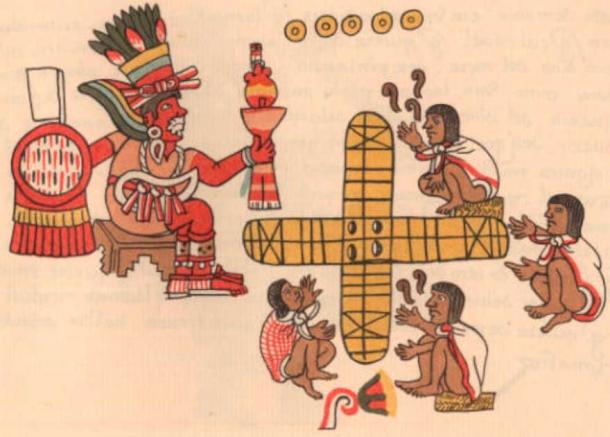
Patolli game being watched by Macuilxochitl (alternate name for Xōchipilli) as depicted on page 48 of the Codex Magliabechiano (Public Domain)
The specific organisms found on the Xōchipilli figurine provide experts with further insight into his influence on Aztec culture. A majority of the organisms found on his statue were hallucinogenic mushrooms, which played a major role in Aztec religious celebrations. These mushrooms were likely either Psilocybe mexicana or Psilocybe aztecorum, native species of mushrooms known for their hallucinogenic effects. These psychedelic fungi were so popular that they were even nicknamed Teonanácatl, which translates to “flesh of the gods.” His association with hallucinogens also marked him as a deity of mild mischief and practical jokes.
Ancient documents and the discovery of Xōchipilli’s statue all point to Xōchipilli representing a variety of human pleasures. Those attending a ceremony or festival worshipping him would often partake in an assortment of activities, including eating psychedelic mushrooms and drinking pulque, an alcoholic drink made from agave. His ceremonies were often a celebration of youth and carefree enjoyment of all life has to offer.

Pulque remains a popular drink with in Mexico today, with various flavors. There’s even a Museo del Pulque y las Pulquerías! (Secretary of the Culture of Mexico City / CC BY 2.0)
Worshippers would adorn Xōchipilli’s statue with flowers, mushrooms, butterflies, and corn as offerings to honor him for his contributions to their culture. Many of his worshippers were male prostitutes and gay men who sought the god’s strength and healing for health and relationship matters. There was also a great deal of male prostitution occurring during the ceremonies themselves. Since Xōchipilli’s celebrations were often focused on human pleasure through sex, drugs, and alcohol anyways, prostitution at these events was common.
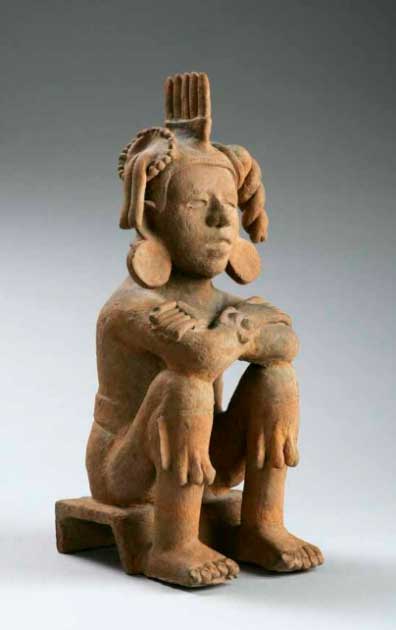
Xochipilli, Aztec God of dance and music, 900-1500 AD (Lombards Museum / CC BY 3.0)
Though Xōchipilli is heavily associated with male prostitution and homosexuality, he was often paired with Xochiquetzal, the goddess of love, fertility, beauty, pregnancy, and childbirth. Xochiquetzal is often seen as Xōchipilli’s female counterpart since both deities are associated with flowers and fertility. They were also both heavily favored by young worshippers for their focus on promiscuity, pleasure, and desire. Rather than being seen as romantic partners, they were often viewed as siblings when paired up.
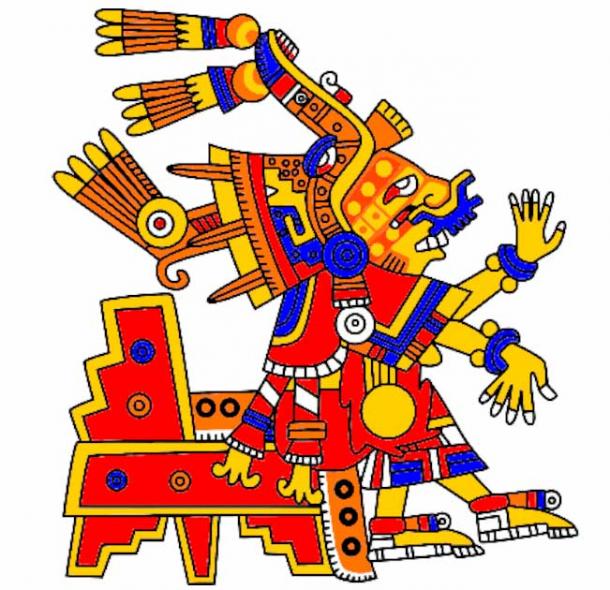
Xochiquetzal, Goddess of Beauty and Love, as depicted in the 16th century Codex Borgia. This Aztec goddess was frequently viewed as Xōchipilli’s female counterpart or sibling. (Public Domain)
Xōchipilli May Inspire You Too
Xōchipilli’s famous statue now resides in the National Museum of Anthropology in Mexico City. Although he is no longer worshipped, his history as an Aztec deity is certainly a fascinating one. Unlike many other deities, he was not perceived as vengeful or frightening. He was beloved for his carefree, lighthearted perspective on life - something many can get behind.
Top image: Left; Aztec god Xochipilli as described in the 16th century Codex Borgia, Right; Xochipilli, Aztec terracotta Lombards Museum. Source: Left; Public Domain Right; CC BY 3.0
By Lex Leigh
References
Cartwright, M. September 6, 2013. Xochipilli. World History Encyclopedia. Available at: https://www.worldhistory.org/Xochipilli/
Goddess of the Month: Xochiquetzal ('quetzal flower'). April 17, 2008. Mexico Lore. Available at: https://www.mexicolore.co.uk/aztecs/gods/goddess-of-the-month-xochiquetzal
Mictlan, M. February 1, 2019. Xochipilli. Atlas Obscura. Available at: https://www.atlasobscura.com/places/xochipilli
O'Brien, C. April 14, 2022. Xōchipilli: Aztec God of Love, Flowers, Poetry, Gay Men, Male Prostitutes, dancing, and fertility. Medium. Available at: https://medium.com/@Charlie_OBrien/x%C5%8Dchipilli-aztec-god-of-love-flowers-poetry-gay-men-male-prostitutes-dancing-and-fertility-8edc551458b2
Patolli. n.d. Cyningstan Traditional Board Games. Available at: http://www.cyningstan.com/game/1165/patolli
The Aztecs, People of the Sun. n.d. Musee Pointe-à-Callière. Available at: https://pacmusee.qc.ca/en/exhibitions/detail/the-aztecs-people-of-the-sun/#:~:text=The%20Aztecs%20worshipped%20the%20Sun,also%20engaged%20in%20human%20sacrifice


















